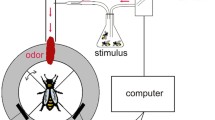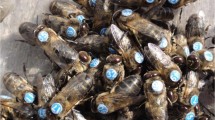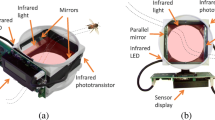Abstract
The response of honey bee (Apis mellifera L.) drones to queen pheromone(s) (either natural from a mated queen, or synthetic from a lure) was recorded using an X-band, ground-based radar. The distribution of drones (insect targets on the radar screen) changed from a scattered distribution to a line concentration (downwind) when the pheromone was released. Displacement within the line concentration was toward the pheromone. This response was seen as far as 800±15 m downwind from a lure with 10 mg of synthetic 9-oxodec-trans-2-enoic acid (9-ODA) and as far as 420±15 m from a mated queen. These studies demonstrate that queen pheromone can be detected by drones at much greater distances than previously believed and illustrate how X-band radar may be used to establish the distances at which insects of similar or larger size respond to pheromones.
Similar content being viewed by others
References
Arn, H. 1990. Pheromones, prophecies, economics and the groundswell, pp. 714–732,in R.L. Ridgway, R.M. Silverstein, and M.N. Inscoe (eds.). Behavior-Modifying Chemicals for Insect Management: Applications of Pheromones and Other Attractants. Marcel Dekker, New York.
Barbier, M., andLederer, E. 1960. Structure chemique de la “substance royale” de la reine d'abeille (Apis mellifera).C.R. Acad. Sci. Paris 250:4467–4469.
Butler, C.G., andFairey, E.M. 1964. Pheromones of the honeybee: Biological studies of the mandibular gland secretion of the queen.J. Apic. Res. 3:65–76.
Butler, C.G., andPaton, P.N. 1962. Inhibition of queen rearing by queen honey bees (Apis mellifera L.) of different ages.Proc. R. Entomol. Soc. London A 37:114–116.
Callow, R.K., andJohnston, N.C. 1960. The chemical constitution and synthesis of queen substance of honeybees (Apis mellifera).Bee World 41:152–153.
Dusenberry, D.B. 1990. Upwind searching for an odor plume is sometimes optimal.J. Chem. Ecol. 16:1971–1976.
Elkington, J.S., andCardé, R.T. 1988. Effects of intergap distance and wind direction on the interaction of gypsy moth (Lepidoptera: Lymantriidae) pheromone-baited traps.Environ. Entomol. 17:764–769.
Gary, N.E. 1963. Observations of mating behavior in the honey bee.J. Apic. Res. 2:3–13.
Koeniger, G. 1986. Mating sign and multiple mating in the honeybee.Bee World. 67:141–150.
Loper, G.M., Wolf, W.W., andTaylor, O.R., Jr. 1987. Detection and monitoring of honeybee drone congregation areas by radar.Apidologie 18:163–172.
Loper, G.M., Wolf, W.W., andTaylor, O.R., Jr. 1992. Honey bee drone flyways and congregation areas-radar observations.J. Kans. Entomol. Soc. 65:223–230.
Murlis, J., andJones, C.D. 1981. Fine-scale structure of odour plumes in relation to insect orientation to distant pheromone and other attractant sources.Physiol. Entomol. 6:71–86.
Murlis, J., Elkington, J.S., andCardé, R.T. 1992. Odor plumes and how insects use them.Annu. Rev. Entomol. 37:505–532.
Pain, J., Barbier, M., andRoger, B. 1967. Quantitative individual analysis of 9-oxydec-2-enoic and 10-hydroxy-dec-2-enoic acids in the heads of worker and queen honey bees.Ann. Abeille 10:45–52.
Perry, J.N., andWall, C. 1984. A mathematical model for the flight of pea moth to pheromone traps through a crop.Phil. Trans. R. Soc. London Biol. Sci. 306:19–48.
Ridgway, R.L., Silverstein, R.M., andInscoe, M.N. 1990. Behavior modifying chemicals for insect management: Applications of pheromones and other attractants. Marcel Dekker, New York.
Ruttner, H., andRuttner, F. 1972. Investigations on the flight activity and mating behavior of drones.Apidologie 3:203–232.
Sabelis, M.W., andShippers, P. 1984. Variable wind directions and anemotactic strategies of searching for an odour plume.Oecologia 63:225–228.
Slessor, K.N., Kaminski, L.A., King, G.G.S., Borden, J.H., andWinston, M.L. 1988. Semiochemical basis of the retinue response to queen honey bees.Nature 332:354–356.
Taylor, O.R., Jr. 1984. A mating tube for studying attractiveness of queen honeybees and mating behavior of drones.J. Apic. Res. 23:21–24.
Wall, C., andPerry, J.N. 1987. Range of action of moth sex-attractant sources.Entomol. Exp. Appl. 44:5–14.
Wolf, W.W.,Vaughn, C.R.,Harris, R., andLoper, G.M. 1993. Insect radar cross sections for aerial density measurements and target classification.Trans. A.S.E. In press.
Author information
Authors and Affiliations
Additional information
Mention of a commercial or proprietary product does not constitute an endorsement by the USDA.
Rights and permissions
About this article
Cite this article
Loper, G.M., Wolf, W.W. & Taylor, O.R. Radar detection of drones responding to honeybee queen pheromone. J Chem Ecol 19, 1929–1938 (1993). https://doi.org/10.1007/BF00983797
Received:
Accepted:
Issue Date:
DOI: https://doi.org/10.1007/BF00983797




